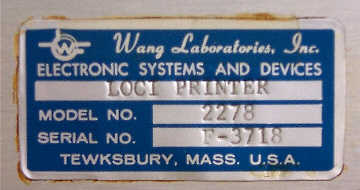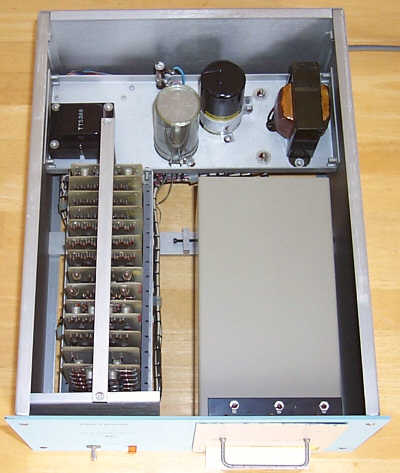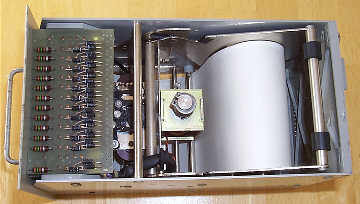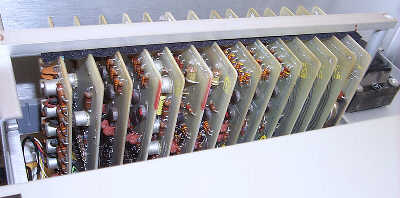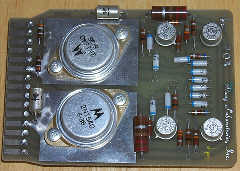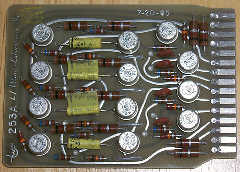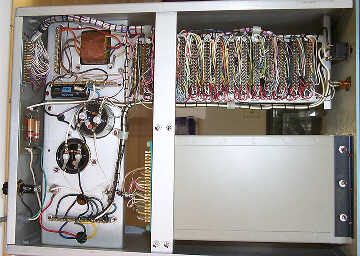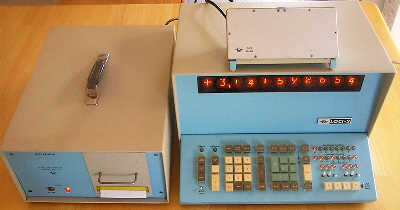

| +Home | Museum | Wanted | Specs | Back | Next |
Wang LOCI Printer
Updated 8/9/2025
Exhibited here is a Wang LOCI Printer. The LOCI printer is a peripheral device designed to connect to a properly-optioned Wang LOCI-2 calculator, providing hard-copy output capabilities for the calculator.The Model/Serial Tag on the LOCI Printer
The LOCI Printer exhibited here was
manufactured in the late part of 1966, based on date code information
on some of the components in the machine. It is intended to be connected
to a LOCI-2 calculator equipped with the "Option D" Input/Output interface.
The I/O interface for the LOCI-2 calculator occupies an option slot in the
calculator that provides a generalized Input/Output bus structure for connection
of peripheral devices.
Inside the LOCI Printer
The LOCI Printer is built in a very
modular fashion, with three main assemblies making up the device.
The 'MODUPRINT' Printer Module
The first component is the printer module.
The printer is contained in a drawer that pulls out of the main
cabinet, to allow paper and ribbon changes. At the back of the printer
module is a circuit board edge connector that mates with a socket inside
the main chassis. This design assures that when the drawer is pulled out,
power is removed from the printer module.
ID Tag on the Printer Module
The printer module using in the LOCI Printer is a Model B3-9 MODUPRINT printer, manufactured for Wang Laboratories
by a company called Practical Automation, Inc., located (at the time) in Shelton, Connecticut. Practical
Automation had its roots in a company called Presin, Co., Inc., located in Bridgeport, Connecticut. Presin
was incorporated in August of 1962. In August of 1966, Presin changed its name to Practical Automation.
Presin/Practical Automation was moderately successful manufacturing and marketing a fairly broad
line of applications-specific and custom printing devices. Markets for their printing devices were
ticket printers for sporting venues, gambling activities, restaurants and fast-food establishments,
inventory systems, as well as custom printers for applications such as the LOCI Printer.
Practical Automation was acquired in 1991 by Alinabal, Inc., in a diversification effort.
The primary business of Alinabal, Inc. is precision metalworking for the aeronautical, military, medical, and recreational
vehicle markets. Along the way Alinabal acquired a number of businesses that augmented the breadth of its market.
Practical Automation was maintained as a business unit of Alinabal, Inc. for a short time, then it apparently
was merged into Alinabal's DACO Instruments division that specialized in sensors and actuators used primarily
in aircraft. At some point after that, it appears that the printer business of Alinabal/DACO was either
shut down or sold, but I have been unable to identify any details concering the disposition of
what was Presin, Inc./Practical Automation. Alinabal, Inc. is still in business, but their website gives
no indication relating to any kind of printing technology.
The MODUPRINT modular printer concept was initially developed by Presin Co., Inc. before it changed
names to Practical Automation. An old Technical Data Sheet was found that was published by Presin describing
their new MODUPRINT Data Printers: Preliminary Bulletin 602.
It appears that this document was printed sometime in early 1966
The Wang LOCI Service Manual references the "Presin Printer" as an option
for the LOCI-2 calculator, indicating that at the time the service manual was
published, which was sometime in 1965, that the name change to Practical Automation had not yet occurred.
The mechanism of the MODUPRINT printer is quite interesting. For a long time, exactly how this printer
worked was a myster, but thanks to a kind visitor to the museum, Mr. Charles
Levinski, the mystery is solved. Mr. Levinski is the sales/product
manager for a company named "HECON". This
company is a long-time manufacturer of specialized ticket and document
printers (among other equipment), and was a competitor of Presin/Practical Automation
in the ticket printer market back in the day.
The technology is called "Modular Printing". The principle is quite simple. Each column to be
printed is served by an individual print module. Each print module contains a wheel that has raised
characters (digits, symbols) around its circumference. The wheel also has
gear-like teeth that are engaged via an escapement mechanism to allow the
wheel to be advanced a character at a time when activated by a small solenoid.
Along with each wheel there is a set of contacts that encode the position
of the wheel, allowing the driving electronics to know when the print wheel
is in the proper position for the selected character or digit to print.
As many of these print modules are assembled together for the number of columns
that the printer needs to print. In the case of the LOCI Printer, there
are twelve modules, one for each column. The modules are arranged so
that a sizable solenoid can push all of the the print wheels firmly up against
the ribbon, which is situated between the print wheels and the paper, causing the selected
characters to be printed. The act of the large solenoid releasing by spring pressure
causes the ribbon to advanced, and the paper to advance to the next line.
The print modules have edge connector fingers at their rear that provide
connections to the soleniod that advances the print wheel, as well as the
contacts that encode the position of the print wheel. The assembled MODUPRINT
module also has a connector at its rear that combines the connections from each of the
print modules, as well as connections to the large solenoid that causing the
printing action.
The modular printer in the LOCI Printer can print up to ten columns of
digits. One column is used for indiating the position of the floating decimal
pointin the number to be printed, and the remaining right-most column
is used solely to print the sign of the number. The print solenoid is quite
powerful, and emits a fairly loud thunk when the printing occurs.
The individual module print-wheel advance solenoids are quite quiet, emitting
only a slight clicking noise as they advance the print wheels. The paper exits
the printer module through a slot at the front of the printer.
According to the tag on the printer, it runs from a 24 Volt DC power
supply, and requires up to 1.6 Amps of peak current. It is suspected that the majority of
this current is drawn when the print solenoid is activated.
The Logic Card-Cage of the LOCI Printer
The next major component of the LOCI printer is the printer logic chassis, which was
designed and manufactured by Wang Laboratories. This logic serves to interface the MODUPRINT
printer module to the LOCI-2 calculator. The all-transistor logic that
controls the printer is located in a tray located at the
left side of the printer chassis. A total of fourteen small Wang LOGI-BLOC circuit boards
make up the circuitry that drives the printer and provides interfacing to the
I/O interface in the LOCI calculator.
Some of the LOCI Printer's Logic Circuit Boards
Some of these circuit boards appear to
be a form of Wang Labs' standard LOGI-BLOC circuit modules, such as one card which appears to
have six three-input logic gates, and another that has eight two-input gates.
These standardized modules were used in Wang's custom process-control and numerical-control
system designs. The circuit boards are made of fiberglass, and have traces on both sides of
the board, with plated through holes. Each board has thirty edge-connector
contacts (fifteen on each side of the baord) for bringing power and logic signals into and out
of the board. The boards plug into a hand-wired backplane using the tried and true
AMP square pin and clip interconnect technology, used extensively in Wang's
early electronic devices. As with the LOCI-2 itself, the majority of the
transistors in the logic are RCA-made 2N404 Germanium devices. One circuit
board has two 2N1540 power transistors which are used to drive the print
solenoid.
The Backplane and Power Supply Wiring
The last component of the printer system is the power supply, made up of two small power
transformers, diode rectifiers, and filtering capacitors. The voltage
supplies do not appear to be regulated, rather, they are simply set
in-situ to deliver the proper voltages using tapped wire-wound power
resistors. The power supply generates the supply voltages for the logic
circuitry (+11/-11 volts), as well as the 24 volt supply used by the MODUPRINT
printer module.
Operation of the printer is
as simple as can be. Simply plug the printer into AC power, plug one end of
the printer cable to the connector on the back of the printer and secure it,
and then plug the other end of the cable into the LOCI-2's port labeled "OUTPUT".
Then, turn on the power to the printer. The printer's power switch is located
on the front panel of the printer, accompanied by a yellow-jeweled pilot lamp
that lights to indicate when the power is turned on. The rear panel of the
printer contains a fuse holder, the fixed power cord, and a single 50-pin female
Centronics-style socket into which the the cable to connect the printer to the
calculator is connected.
To advance the paper, it can simply be pulled out manually, or the printer can be
commanded to do so from the calculator, by pressing the [CAR'GE RET] key on the
Option D-equipped LOCI-2 keyboard (or through a program via operation code 75).
To print the content of the LOCI-2's display, the [WRITE] (operation code 11) key is
pressed. The printer prints about one line per second. The calculator waits
for the printer to complete its cycle before proceeding to the next instruction when
operating within a program.
While being a numeric-only printer, the LOCI Printer was certainly an invaluable peripheral for the LOCI-2
calculator, allowing the results of manual or programmed calculations to be permanently and accurately
recorded on paper. Without such a device, the results of calculations would have to be manually copied onto paper
from the Nixie tube display, which could result in transcription errors. It appears that later, Wang
Labs developed an interface for the LOCI-2 calculator to provide a bi-directional connection to a
Teletype Corp. Model 33-ASR Teletype. This interface provided the ability to print alphanumerics
on the Teletype printer, as well as control of the formatting of printing the number in the calculator's display.
The Teletype interface also provided the ability to read program steps and data from the Teletype's built-in
eight-channel punched paper tape reader, vastly increasing the programming capability of the LOCI-2
as compared to the punched card readers. It was also possible to provide input data to programs
from the Teletype's keyboard.
There also appears to have been an interface developed to connect an IBM
computer console typewriter to the LOCI-2. This interface provided similar capability as the Teletype interface,
but was output-only, allowing alphanumerics and the content of the display to be printed out on the typewriter.
These later interfaces were considerably more flexible than the LOCI Printer, allowing for annotation of
printed output that the LOCI Printer was not capable of. It appears that Wang Laboratories offered the
Teletype interface as a customer product, but it is not clear if the IBM Output Typewriter interface
was available to customers, and was only used in Wang Labs custom products.
